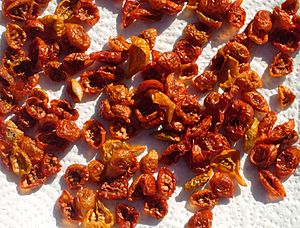Sun-dried tomato facts for kids
Sun-dried tomatoes are ripe tomatoes that have most of their water removed by drying in the sun. This process makes them last longer and gives them a very strong, sweet, and tangy flavor.
Sometimes, before they are put in the sun, tomatoes are treated with a little salt or a special gas called sulfur dioxide. This helps them keep their bright color and look nice. Tomatoes usually spend about 4 to 10 days drying in the sun. Small cherry tomatoes can lose 88% of their weight, while bigger tomatoes can lose up to 93%. This means it takes a lot of fresh tomatoes to make just a small amount of sun-dried ones. For example, you might need 8 to 14 kilograms of fresh tomatoes to make only one kilogram of sun-dried tomatoes!
After they are dried, these tomatoes are still very good for you. They are full of healthy things like lycopene, antioxidants (which help protect your body), and vitamin C. The final product might have a small amount of salt, which adds to your daily salt intake.
Sun-dried tomatoes can be used in many different recipes. They come in various shapes, colors, and types. Traditionally, they were made from red plum tomatoes, but you can also find yellow ones. You can even buy sun-dried tomatoes as a paste or purée.
Often, sun-dried tomatoes are kept in sunflower or olive oil. Sometimes, other tasty ingredients like capers, garlic, or different herbs are added to the oil for extra flavor.
Contents
A Look Back: History of Sun-Dried Tomatoes
Tomatoes were first dried and salted to keep them from going bad. Removing the moisture from tomatoes, like with most foods, helps them last much longer. By drying ripe tomatoes, people could enjoy them and get important nutrients even in winter, when it was hard to grow fresh food.
Where Did They Start?
We don't know exactly where sun-dried tomatoes first came from. However, people in Italy used to dry their tomatoes on their ceramic rooftops under the summer sun. This was a common way to preserve them.
Popularity Over Time
Sun-dried tomatoes became very popular in the United States in the late 1980s and early 1990s. You could find them in many dishes like antipasto (Italian appetizers), tapas (Spanish snacks), pasta dishes, and salads. They were a big food trend for a while. However, by the end of the 1990s, they became less popular because people used them so much that they became common.
See also
 In Spanish: Tomate seco para niños
In Spanish: Tomate seco para niños


